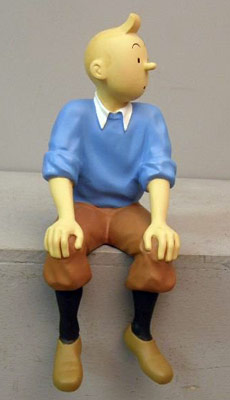
PARIS (AP) – Comics, long a staple of the French literary diet, are moving to center stage.
From Asterix and Obelix to Tin Tin to the brooding comic book hero Largo Winch, the French public has long adored their cartoon heroes. Now the visual world of comics is being embraced for the first time by Paris’ Louvre museum.
In the hazy lighting and hollow stone walls of the Louvre’s Medieval hall, Bernar Yslaire brought the latest character from his comic strip The Sky above the Louvre – a tempestuous young revolutionary – to life.
The Belgian cartoonist, 52, invited the live audience into his digital world of comics, where images are created not with a sketchpad and crayon, but at the click of a mouse.
“My comic strip is done exclusively on a digital screen, there is no paper at all,” Yslaire says. “We are in the 21st century of communication.”
Using his “electronic pencil,” each carefully poised click slowly revealed his protagonist: first the raging, raven eyes, then a sharp, angular nose, unkempt curly hair and finally the broad shoulders.
The exhibition, Small Design: The Louvre invites Comics, opened Thursday. Comic strips from five authors will be displayed, with Yslaire, who gave a display Wednesday, performing live again April 3.
Three works have already been completed: Glacial Period, by Nicolas de Crécy, Marc-Antoine Mathieu’s The Basement of the Louvre and Eric Liberge’s Odd Hours.
Yslaire’s comic book will be completed in May 2009, while Hirohiko Araki’s manga, Rohan at the Louvre, is set for release next year.
In each of the works, the Louvre is the principal location. Yslaire’s story takes place in 1793, where the painter David is ordered to create a portrait for Maximiliem Robespierre in the newly inaugurated Louvre.
Yslaire’s comic strip, only in sepia or black and white, reflects the somber tones of an incumbent revolution. Occasional splashes of red, he says, “remind readers that there is life, blood, sadness and love.”
What place, one might wonder, do animated characters and laconic dialogue have in one of the world’s most prestigious museums?
Curator Fabrice Douar says the initiative is not about “modernizing” the Louvre, nor about “validating” comic strips as an art, nor about engaging with the youth.
“We wanted to present this art with the goal of showing its … aesthetic quality, but also its quality in the sense of the confrontation between the world of the Louvre and this alternate universe, which is that of comics,” he says.
Each comic strip was chosen to reflect the diversity of the art.
“Comics are not just something lighthearted … there are also contemporary comics, which is more about the creation – there are graphic novels, detective stories and manga,” he adds.
The exhibition hopes to break down stereotypes not just about comic books but also about world-famous museums like the Louvre.
“Just like comics are not only fun or for entertainment, the Louvre equally is not dusty and boring,” Douar says.
AP-CS-01-22-09 0907EST
Copyright 2009 Associated Press. All rights reserved. This material may not be published, broadcast, rewritten, or redistributed.


